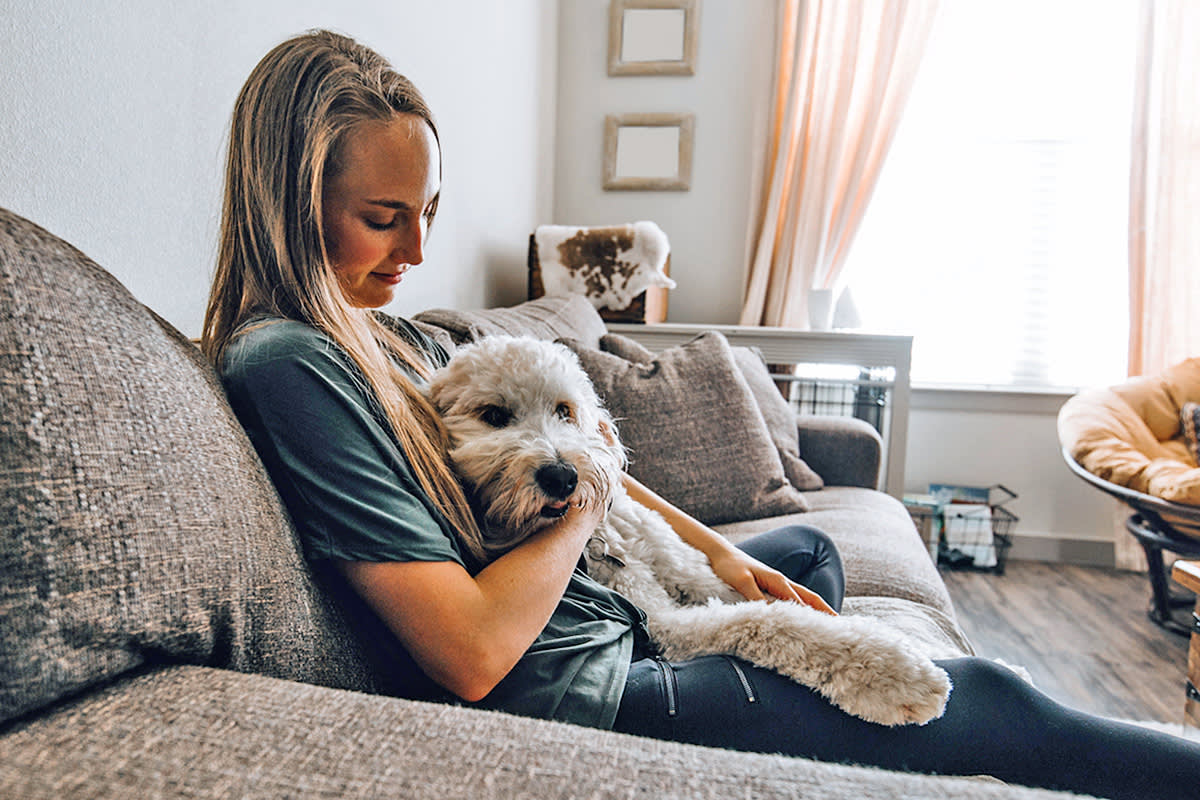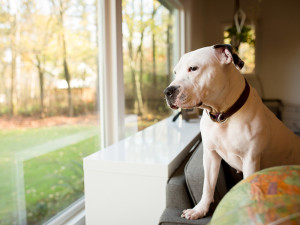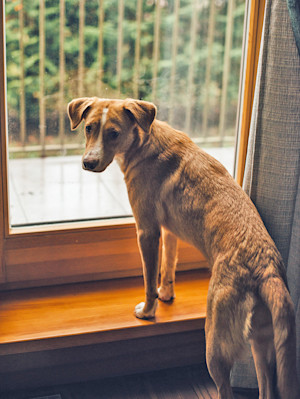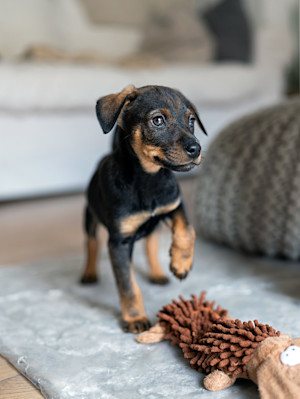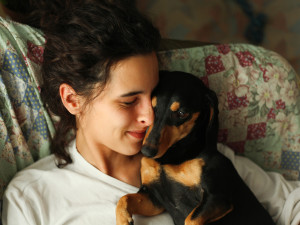Who Really Has the Separation Anxiety—You or Your Dog?
A dog mom realizes her pup will be just fine when he’s home alone.
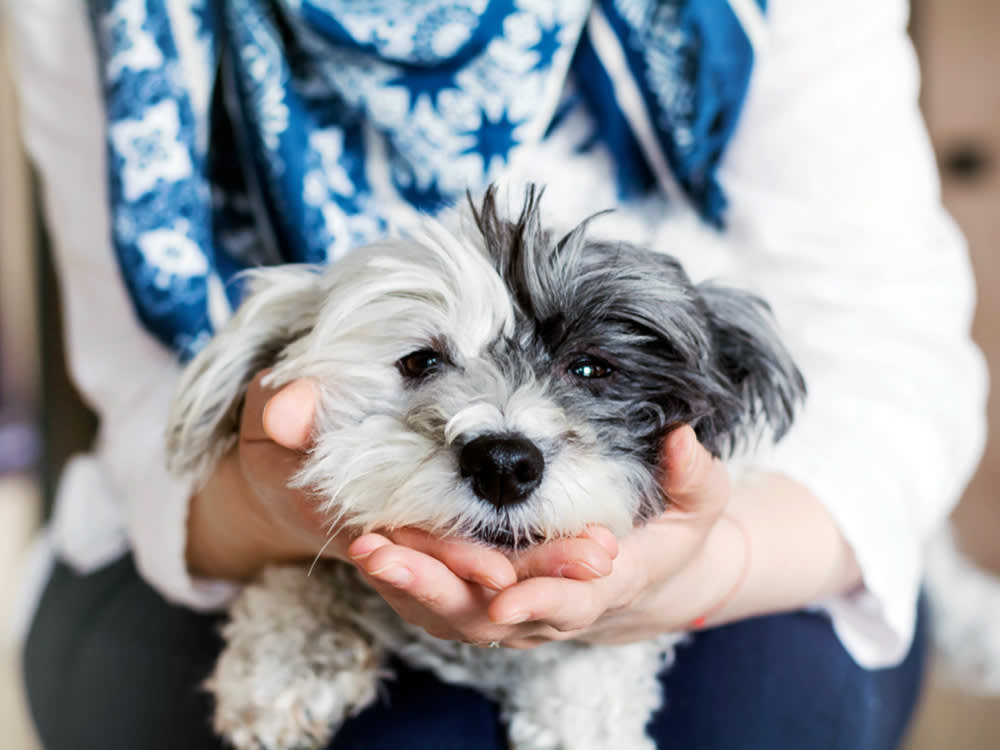
Share Article
I became a first-time dog mom almost two years ago, when I picked up my nine-week-old Havanese puppy, Briar, in February 2024. The second I laid eyes on that two-pound ball of black fluff, I knew I was in trouble.
I like to joke with my husband that I gave birth to Briar; she even looked like me as a baby (don’t ask me to explain). Now, at almost two years old, Briar is my firstborn, my little shadow, and one of my greatest loves.
Like most new pet parents, I’ve faced my fair share of challenges. Briar has struggled with potty training (she still occasionally poops inside… oops), leash walking, and her general nervousness about the big city. But nothing prepared me for the hardest part of all: leaving her home alone.
Those early days were brutal for me. As soon as we closed the front door, Briar would claw at it, cry, howl, and bark like her life depended on it. Not only was I worried about her feelings, but I was also concerned that her barking and crying would really annoy the neighbors in our building.
How much do you spend on your pet per year?

I’d open the Furbo pet cameraopens in new tab app every few minutes, watching and talking to her through the camera. “Lie down,” I’d say softly in my soothing mom voice. “It’s OK, baby. You’re gonna be OK.” We even put her on a low dose of anxiety medication (pet parents in New York City, IYKYK), thinking it might help her separation anxiety.
What I’ve come to realize is that I wasn’t just checking on Briar. I was actually doing everything I could to soothe myself. I thought I was being a responsible dog mom by carefully managing my pup’s anxiety. But months later, I realized that Briar wasn’t the one with separation anxiety. I was.
When I realized she was fine (and I wasn’t)
As Briar got older, I started to get frustrated with this feeling that I (or someone else) always needed to be home to make sure Briar didn’t feel lonely and sad. I realized that the stay-at-home-all-day-for-Briar model wasn’t really working for my busy life in the city.
While my husband was at work, and I was off going to various work events around town, I had to force myself to leave her for longer periods of time (like three to four hours), and essentially watch her “cry it out.” Seeing my little girl go through this felt heartbreaking to me. It felt like I was abandoning her and that she would hate me for leaving her for so long.
I saw a TikTok video once about how you should fully explain to your dog where you’re going and when you’ll be back. So of course, my husband and I started telling her all the details of our comings and goings. If I was only going out for a short while to run some quick errands, I’d tell Briar, “I’ll be right back.” If I was planning on leaving her for hours at a time, I’d say, “Go lie down,” so that she knew I would be gone for a while and not to wait up for me.
After weeks of leaving her home alone a handful of times, a miracle happened: On our Furbo, I found her curled up into a ball on the couch, resting her eyes and looking peaceful. The wave of relief I felt in that moment was intense. I think I might have even teared up.
How dogs mirror our energy
A dog can sense when a person is anxious or stressed by their outward behaviors, just like humans can recognize in each other (and in our pets). “It’s not chemical dog magic, but simple behavior observation — pets can feed off of their owner’s stress behaviors, just like humans,” explains Rhea Northcut, a certified professional dog trainer and resident separation anxiety expert at Wiggle Butt Academyopens in new tab.
Northcut adds: “If they see us acting differently in certain periods, they are going to notice and potentially feel stressed about our behavior change. Pets can also have their own stress and anxiety, particularly surrounding separation, even in the absence of human stress.” Unfortunately, our pets’ stress can also affect our stress. It can be a vicious cycle.
According to Northcut, if we are looking extra emotional about leaving, our dogs will notice. “What we’re feeling internally isn't necessarily the problem — it’s about how we show it,” she says. “This is where putting on a brave face for our dogs is a good practice.”
When leaving your dog at home, old advice would suggest ignoring your dog for 30 minutes before leaving the house and ignoring them when you return. “However, as discussed above, our dogs take note of our behavior changes, and they rely on our outward behaviors to navigate their world inside the home with us,” Northcut explains. “If we remove all social cues, our dogs are basically flying blind.”
Northcut recommends staying nonchalant about it. A quick “See ya later” on exit and a gentle “Hi, buddy” on return is plenty. “We want to remove the anxious language like, ‘It’s OK, buddy. You're gonna be OK. I’ll be right back. I know it’s hard. I’m sorry,’ all while the owner is looking pained or even crying, is going to make things worse for our dogs,” Northcut says. “Keep exits and entries chill and no big deal while still keeping lines of communication open.”
Why we feel so guilty when we leave our dogs behind
OK, so maybe your dog has chilled out while you’re gone, but you’re still struggling with feeling guilty and anxious about not being there. According to Jaclyn Spiegelopens in new tab, a licensed clinical social worker, anxiety can manifest when pet parents leave their pet at home due to broader attachment patterns, fear of abandonment, or control issues.
“Individuals who are anxiously attached may struggle with self-worth and rely on their pet’s unconditional love as a source of security and boost to their sense of self,” she explains. “Anxiously attached folks often fear that their loved ones will abandon them and project this anxiety onto their pet, assuming that they will feel abandoned by them.” Additionally, the inability to monitor their pet’s every move and safety may be difficult for those who struggle to relinquish control.
And yes, humans can get separation anxiety from their pets, too. According to Speigel, a human’s struggle to be apart from their pet could be considered a reverse separation anxiety. “While separation anxiety is more commonly attributed to pets, owners can experience overwhelming discomfort and worry associated with leaving their pet,” she explains.
Someone’s anxiety about leaving their pet may be interfering with their mental health if they are doing any of the following:
Cancelling plans for fear of leaving their pet home alone
Not engaging in activities or taking trips for fear of leaving their pet home alone
Checking in on their pet via pet camera or text incessantly throughout the day
Experiencing physical symptoms of anxiety associated with not being near their pet
Worrying about their pet to the point where it starts to interfere with either their social or professional life
Learning to trust myself (and my dog)
Once I got to the point where I realized that staying home with Briar was affecting my personal and professional life, I decided that I needed to leave her home alone for hours at a time, let her cry it out, and pray that she learned to rest by herself. My husband would constantly tell me, “She’s OK; she’s fine,” and he would encourage me not to check the Furbo often, if at all.
Before I left, I always made sure that she had been walked or that I played with her inside a lot, so that she was physically tired. I would put white noise on the TV, and put the pillows on our couch horizontally, so that she had a cozy spot to rest.
I’d say, “Go lie down,” and that would be her cue to take a nap because both her parents were gonna be gone for a while. I made sure to project confidence as I left and constantly reminded myself that she was safe and that she would be OK. After a while, I noticed that every time I told Briar to “go lie down” before I left, she would jump on the couch and curl into a pillow.
“When you breathe slower, move gently, and soften your voice, your dog’s body picks up on that safety cue,” says Sian Lawley-Rudd, founder of Lavender Garden Puppy and Dog Trainingopens in new tab. “Their heart rate slows, their muscles relax — it’s emotional co-regulation in action. Calm really is contagious both ways.”
I did continue to check the Furbo every so often, and when I saw that Briar would just be laying on the couch sleeping, my confidence in her independence skyrocketed. “I stand by having a camera set up in your home — for those who are anxious about it, the best thing for them is to see their dog relaxing while they are out,” explains Northcut. “Our dogs can't go everywhere with us, nor do they need to… We have a responsibility to provide our dogs with not only a life they can survive, but a life where they can thrive. However, we also owe it to ourselves not to sacrifice our wellbeing to make that possible. Life with dogs is such a beautiful balance.”
Reframing the narrative
If you’re also struggling to leave your sad pup home alone, there are various reframes that can help manage your guilt associated with leaving the house. Speigel says these are some simple thoughts you can keep in mind:
Your absence allows your dog to rest. As long as you are offering them opportunities for physical activity throughout the day, they are likely perfectly content to take the opportunity to sleep.
It’s important to acknowledge that animals do not necessarily experience emotions the same way humans might.
Remind yourself of all the ways you care for your pet’s needs when you’re with them.
For folks experiencing physical anxiety symptoms around leaving their dog at home alone, Spiegel suggests:
Breathing exercises, such as breathing in for three seconds, holding for three seconds, and breathing out for three seconds.
Grounding exercises, such as the 5-4-3-2-1 technique. To do this, name five things you can see, four things you can touch, three things you can hear, two things you can smell, and one thing you can taste, which brings your attention back to the present moment.
Building a schedule around how often and when you check in on their pet.
Rather than telling yourself, “I’m abandoning my dog,” try to remind yourself that you love and care for your pet by first taking care of yourself. “I will only be able to take care of my pet in the ways they need, if my own needs are met.”
Another way to think about it: Separation is part of the socialization process. “Socialization for your pup is not just about meeting people and other dogs,” Northcut says. “It’s also about getting accustomed to life’s experiences, too.”
Finding balance
It’s been about a year since we started leaving Briar alone, and I no longer suffer from intense anxiety about it. Briar and I have both learned a little independence. These days, she naps on our bed and barely lifts her head when we say goodbye. Honestly, it sometimes feels like she’s waiting for us to leave so she can finally have some peace and quiet.
There’s no camera in our bedroom, and I find myself checking the Furbo in our living room very infrequently. I’ve learned that giving her space to rest isn’t a sign that I love her less; it’s actually a sign that I love her enough to let her be.

Daley Quinn
Daley is a longtime journalist and copywriter based in New York City. Her work has appeared in publications including New York Magazine, Real Simple, TODAY, Well + Good, and many more. Daley is the proud mom to her incredibly sweet n' small two-year-old Havanese puppy, Briar Rose.
Related articles
![Muscular white pit bull stands on couch, looking out window to sunny fall day.]()
Separation Anxiety in Dogs
Does your dog freak out when you head for the door? Here’s some advice.
![Sad dog waiting by window at home.]()
6 Lies You've Been Told About Your Dog’s Separation Anxiety
Remember, it’s not your fault, no matter what anyone says.
![Sad black dog staring outside a window at home.]()
How to Ease Your Puppy’s Separation Anxiety
It’s not easy for either of you—but this can help.
How Long Can a Puppy Be Left Alone?
Because you have to go places sometimes.
![Puppy playing at home with his toy alone.]()
Tips for Leaving Your Puppy Home Alone for the First Time
![Young woman hugging her small black dog on the couch]()
Who Has More Separation Anxiety — You or Your Dog?
It was a trick question. A study shows that the pandemic has made us all codependent.

